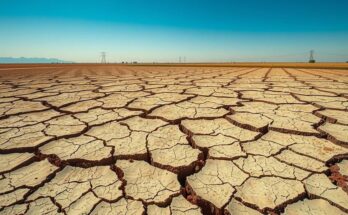A magnitude 4.1 earthquake struck Nice and Côte d’Azur on March 18, 2025, startling residents without causing injuries or substantial damage. An aftershock of 3.7 magnitude followed, with local geologist Christophe Larroque noting the rarity of such strong quakes in the region. The event emphasized the importance of preparedness for future seismic activity in this moderate-risk area of France.
On March 18, 2025, at 18:45, a magnitude 4.1 earthquake shook Nice and the Côte d’Azur, startling residents across the region. The epicenter was located approximately 16 kilometers north of the city, with tremors felt in Var, Monaco, and parts of Italy. Although there were no injuries or significant damage reported, the event caught many locals by surprise, meriting extensive comments on social media. Witness accounts described the quake as powerful, with one individual expressing, “C’est bien la première fois qu’un tel séisme a lieu dans la région, à ce point-là. Impressionnant… C’est vraiment flippant.” The intensity lasted around five seconds, causing windows and furniture to rattle.
Following the main quake, a magnitude 3.7 aftershock occurred around 22:25 in the vicinity of the first tremor. The Réseau National de Surveillance Sismique (Renass) confirmed these seismic events, noting that while earthquakes in the sequence occur regularly, such magnitudes are infrequent in the area. Christophe Larroque, a geologist at CNRS GéoAzur, commented on the relative rarity of significant tremors, stating, “Ce n’est pas exceptionnel. On a déjà ressenti des séismes de cette puissance-là,” highlighting that this was the first major quake felt in nearly two decades.
The Côte d’Azur has experienced seismic activity, albeit moderately compared to regions like Japan or Chile. Since the establishment of a seismic zoning system in 2011, certain areas in France, such as Pays de la Loire and Nouvelle-Aquitaine, have been classified with moderate seismic risk. On the contrary, overseas territories like Guadeloupe and Martinique face high risks due to their geological positioning between tectonic plates. Annually, France records about one hundred earthquakes with a magnitude above 3, with a higher frequency in its overseas territories.
The updated seismic zoning indicates that roughly 21,000 municipalities in France are within risk zones, significantly surpassing the 5,000 noted in prior mappings from 1991. Major cities like Nice are recognized as particularly vulnerable to seismic activity. The historical context reveals that the region has faced significant quakes previously, including a 5.4 magnitude earthquake in 2019 that injured several individuals near Le Teil, and a more recent tremor in June 2023 with magnitudes ranging from 5.3 to 5.8 affecting western France.
In response to the tremors, officials have provided assurances that there is no immediate threat of a tsunami and reaffirmed the necessity for continued preparedness regarding potential aftershocks. Social media reactions ranged from panic to humor, with one Twitter user stating, “Wow le séisme à l’instant à Nice le grondement, j’avais jamais vu ça.” This earthquake reflects not only a resilient attitude among the residents of the Côte d’Azur but also the ongoing need for awareness of seismic risks in their lives.
In summary, although the earthquake in Nice did not inflict physical damage, it underscored the importance of vigilance and preparedness for seismic activity. France’s moderate seismicity and comprehensive zoning system are critical in ensuring that residents are informed and equipped to respond to natural events effectively, thus enhancing the community’s resilience against such occurrences in the future.
The magnitude 4.1 earthquake in Nice on March 18, 2025, serves as a critical reminder of the seismic activity present in the Côte d’Azur. While no injuries or severe damage were reported, the event highlighted the necessity for awareness and preparedness among residents. Continued vigilance, in conjunction with France’s seismic zoning classifications, aims to mitigate risks associated with such natural disasters, thus ensuring community safety and resilience.
Original Source: evrimagaci.org




